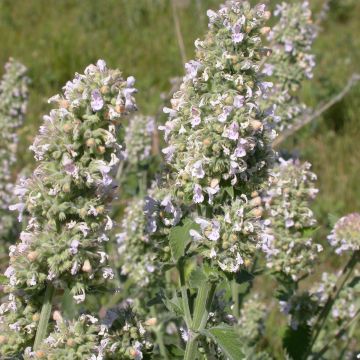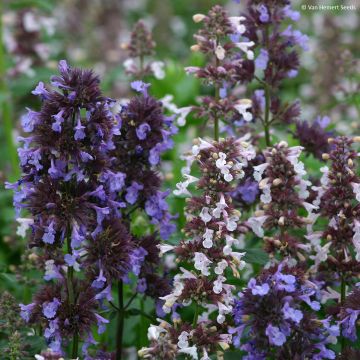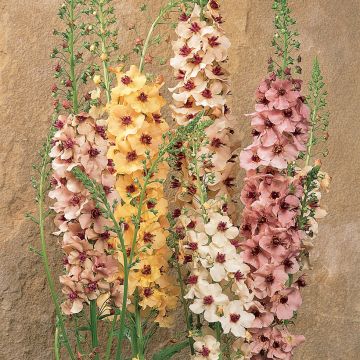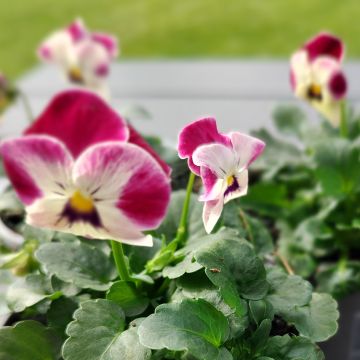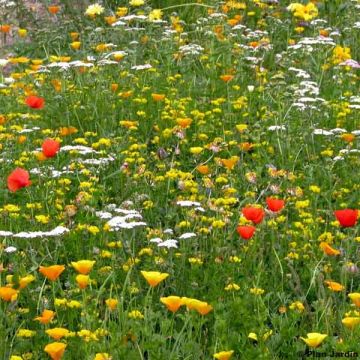

Graines d'Agave (Mixed) - Agaves en mélange
Agave Mixed
Agave Mixed
This plant carries a 6 months recovery warranty
More information
We guarantee the quality of our plants for a full growing cycle, and will replace at our expense any plant that fails to recover under normal climatic and planting conditions.
Seed-only orders are dispatched by sealed envelope. The delivery charge for seed-only orders is €3.90.
Does this plant fit my garden?
Set up your Plantfit profile →
Description
This mix of agaves offers a wide selection of plants, with many varieties of unusual shapes. These perennial succulents have an exotic appearance and are ideal for container gardens or rockeries in mild climates. Hardiness varies depending on the species, but all show good drought resistance and are easy to grow.
Exclusively American, found spontaneously in the Caribbean and southern United States, Mexico and the Antilles, agaves are extremely decorative plants, typical of warm countries and arid soils. They have slender, fleshy leaves, often bordered with sharp teeth. Small species take five to ten years to flower, while large ones can take up to forty years. These are semelparous plants, whose single flowering leads to death. The tall flowering stalk (up to 8m (26ft) high in Agave americana) emerges from the centre of the rosette and bears numerous tubular flowers arranged in panicles. The rosettes that develop at the periphery of the mother plant take over when the parent plant dies.
Agaves have a unique architectural presence. They have a special place in Mediterranean gardens, rockeries, or collections of potted plants. You can plant ground covers of the same undemanding temperament at their base: evening primroses, osteospermums, felicia, or witch's claws, which will fill the space with their flowering and evergreen foliage and hide the void left by a dead plant.
Certain parts of the agave are edible: the flowers, leaves (in spring they are richer in juice), floral stems (when roasted, they are sweet like molasses), and the juice, also called aguamiel (which means honey-water). Food derivatives like agave sugar are easily available. Before the arrival of the Spanish, the Native Americans produced a weakly alcoholic beverage by fermenting the juice of Agave atrovirens. The conquistadors distilled this beverage and gave birth to mezcal and tequila, obtained from the hearts of Agave tequilana.
Report an error about the product description
Flowering
Foliage
Plant habit
Botanical data
Agave
Mixed
Agavaceae
Cultivar or hybrid
Other Thompson and Morgan seeds
Planting and care
Sow the agave seeds from February to July in trays, pots, etc. in a special seed compost. Place the seeds in a mini greenhouse or a warm place to maintain an optimal temperature of 20 to 25°C (68 to 77°F). Keep the seeds in the light. Do not cover the seeds. Upon germination, sprinkle the periphery of the plants with a light pinch of coarse gravel to support the young seedlings and prevent them from being in contact with too much moisture.
Transplant into 5cm (2in) pots, then 8cm (3in), and finally 15cm (6in), watering sparingly until transplantation into open ground or final containers.
Sowing period
Intended location
This item has not been reviewed yet - be the first to leave a review about it.
Flower seeds
Haven't found what you were looking for?
Hardiness is the lowest winter temperature a plant can endure without suffering serious damage or even dying. However, hardiness is affected by location (a sheltered area, such as a patio), protection (winter cover) and soil type (hardiness is improved by well-drained soil).

Photo Sharing Terms & Conditions
In order to encourage gardeners to interact and share their experiences, Promesse de fleurs offers various media enabling content to be uploaded onto its Site - in particular via the ‘Photo sharing’ module.
The User agrees to refrain from:
- Posting any content that is illegal, prejudicial, insulting, racist, inciteful to hatred, revisionist, contrary to public decency, that infringes on privacy or on the privacy rights of third parties, in particular the publicity rights of persons and goods, intellectual property rights, or the right to privacy.
- Submitting content on behalf of a third party;
- Impersonate the identity of a third party and/or publish any personal information about a third party;
In general, the User undertakes to refrain from any unethical behaviour.
All Content (in particular text, comments, files, images, photos, videos, creative works, etc.), which may be subject to property or intellectual property rights, image or other private rights, shall remain the property of the User, subject to the limited rights granted by the terms of the licence granted by Promesse de fleurs as stated below. Users are at liberty to publish or not to publish such Content on the Site, notably via the ‘Photo Sharing’ facility, and accept that this Content shall be made public and freely accessible, notably on the Internet.
Users further acknowledge, undertake to have ,and guarantee that they hold all necessary rights and permissions to publish such material on the Site, in particular with regard to the legislation in force pertaining to any privacy, property, intellectual property, image, or contractual rights, or rights of any other nature. By publishing such Content on the Site, Users acknowledge accepting full liability as publishers of the Content within the meaning of the law, and grant Promesse de fleurs, free of charge, an inclusive, worldwide licence for the said Content for the entire duration of its publication, including all reproduction, representation, up/downloading, displaying, performing, transmission, and storage rights.
Users also grant permission for their name to be linked to the Content and accept that this link may not always be made available.
By engaging in posting material, Users consent to their Content becoming automatically accessible on the Internet, in particular on other sites and/or blogs and/or web pages of the Promesse de fleurs site, including in particular social pages and the Promesse de fleurs catalogue.
Users may secure the removal of entrusted content free of charge by issuing a simple request via our contact form.
The flowering period indicated on our website applies to countries and regions located in USDA zone 8 (France, the United Kingdom, Ireland, the Netherlands, etc.)
It will vary according to where you live:
- In zones 9 to 10 (Italy, Spain, Greece, etc.), flowering will occur about 2 to 4 weeks earlier.
- In zones 6 to 7 (Germany, Poland, Slovenia, and lower mountainous regions), flowering will be delayed by 2 to 3 weeks.
- In zone 5 (Central Europe, Scandinavia), blooming will be delayed by 3 to 5 weeks.
In temperate climates, pruning of spring-flowering shrubs (forsythia, spireas, etc.) should be done just after flowering.
Pruning of summer-flowering shrubs (Indian Lilac, Perovskia, etc.) can be done in winter or spring.
In cold regions as well as with frost-sensitive plants, avoid pruning too early when severe frosts may still occur.
The planting period indicated on our website applies to countries and regions located in USDA zone 8 (France, United Kingdom, Ireland, Netherlands).
It will vary according to where you live:
- In Mediterranean zones (Marseille, Madrid, Milan, etc.), autumn and winter are the best planting periods.
- In continental zones (Strasbourg, Munich, Vienna, etc.), delay planting by 2 to 3 weeks in spring and bring it forward by 2 to 4 weeks in autumn.
- In mountainous regions (the Alps, Pyrenees, Carpathians, etc.), it is best to plant in late spring (May-June) or late summer (August-September).
The harvesting period indicated on our website applies to countries and regions in USDA zone 8 (France, England, Ireland, the Netherlands).
In colder areas (Scandinavia, Poland, Austria...) fruit and vegetable harvests are likely to be delayed by 3-4 weeks.
In warmer areas (Italy, Spain, Greece, etc.), harvesting will probably take place earlier, depending on weather conditions.
The sowing periods indicated on our website apply to countries and regions within USDA Zone 8 (France, UK, Ireland, Netherlands).
In colder areas (Scandinavia, Poland, Austria...), delay any outdoor sowing by 3-4 weeks, or sow under glass.
In warmer climes (Italy, Spain, Greece, etc.), bring outdoor sowing forward by a few weeks.




































